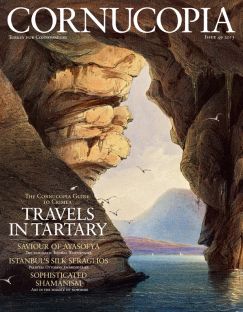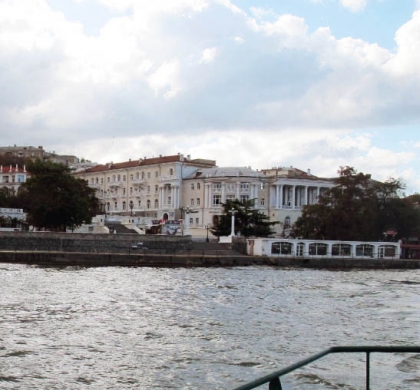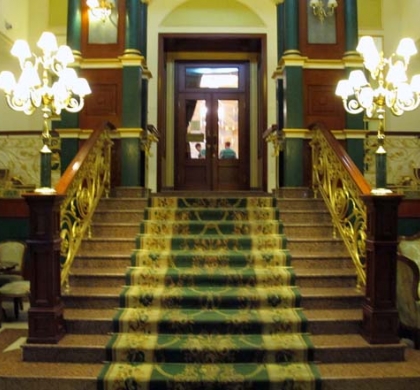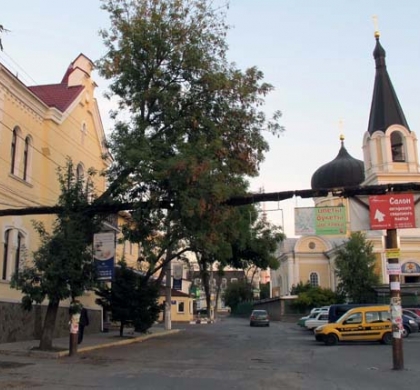Buy or gift a stand-alone digital subscription and get unlimited access to dozens of back issues for just £18.99 / $18.99 a year.
Please register at www.exacteditions.com/digital/cornucopia with your subscriber account number or contact subscriptions@cornucopia.net
Buy a digital subscription Go to the Digital EditionThe Crimean khans started building their palace at Bahçesaray (literally Garden Palace) around 1530 and went on adding pavilions and baths, courtyards and gardens for the next 250 years. Their capital turned into a miniature Ottoman city, their palace into a miniature Tokpapı. The palace is a unique gem – the only one of Ottoman design to survive outside Istanbul.
In the 1680s Evliya Çelebi, the Ottoman courtier and traveller, enthused that the palace of Bahçesaray was ‘surrounded by four gardems the equal of paradise, and from that this town gets its name’. Today, when you step through the north-facing arched gateway, the Darphane Kapısı (the Gate of the Mint), you find what feels like a lively village square.
The Khan’s Mosque stands behind colonnade of pointed arches on the left. Its jewel is the adjoining loggia for the khan, with its separate entrance, delicate arches and wide eaves. Inside its walls are covered with Iznik tiles from the Tekfur Saray workshop in Istanbul, which was still operating in the 1730s when the palace was restored after being sacked by the Russians in 1736.
Catherine the Great famously came to stay in the palace on May 14, 1787. It was the ultimate goal of a triumphal progress that had begun in St Petersburg in December 1786. Her successors would take a particular interest in the restoration and the maintenance of the palace, employing a succession of talented architects, such as William Hastie, who made invaluable planned drawings that are now in the National Library of Russia, in St Petersburg.
During the Crimean War the palace was unfortunately used as a hospital. A witness wrote: ‘The palace has suddenly aged by 50 years. The Moorish mats have disappeared, as have the marble tables, the cunningly crafted painted mirrors, the china candlesticks, the crystal chandeliers and the khans’ wives’ wardrobe.’
On the left, beyond the mosque, stands a graveyard and two very Ottoman-looking domed türbe.
The harem and the pavilions that served as reception halls are on the right of the square.
Only 20 years after Mehmed the Conqueror captured Istanbul, Crimea became an important, but autonomous, part of his burgeoning Ottoman Empire. After 1475 the Crimean khans, descendants of Genghis Khan, increasingly came under Ottoman sway. They started building their capital and palace at Bahçesaray (literally Garden Palace) around 1530, and went on adding pavilions and baths, courtyards and gardens for 250 years. The town turned into a miniature Ottoman city, their palace into a miniature Topkapı.
Bahçesaray’s small size belies its significance. The palace is a unique gem – the only one of Ottoman design to survive outside Istanbul. And Crimean Tatars have exerted a strong influence on Turkey, first as mounted archers vital to the expanding empire, and more recently as prominent figures in the arts, educational reform and Ottoman historical research.
Not much is left of the town Bossoli painted here, but the Turkish connection – and the Tatars’ Turkic language – have survived Catherine the Great’s annexation, Stalin’s Terror and exile of the Tatars, and recent upheavals in Ukraine and Russia.
Bossoli shows the palace as a harmonious assembly of low buildings round a spacious courtyard. On the left, walled gardens lead from the octagonal Falcon Tower to the pavilions of the harem and the audience hall. On the right are the minarets of the great Friday mosque and the monumental tombs of the rulers.




 Issue 66, December 2023
Turkey’s Centenary Issue
Issue 66, December 2023
Turkey’s Centenary Issue

Cornucopia works in partnership with the digital publishing platform Exact Editions to offer individual and institutional subscribers unlimited access to a searchable archive of fascinating back issues and every newly published issue. The digital edition of Cornucopia is available cross-platform on web, iOS and Android and offers a comprehensive search function, allowing the title’s cultural content to be delved into at the touch of a button.
Digital Subscription: £18.99 / $18.99 (1 year)
Subscribe now